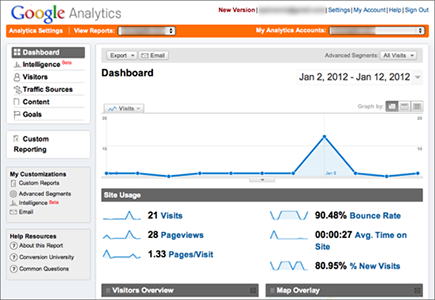Figure 5-1: The Google Analytics graph of a new website
Battling Denial and Isolation
The biggest struggle you’ll face when embarking on metrics gathering and analysis is feeling alone and unheard at first. Any new campaign, website, Twitter account, Facebook page, or other item you want to measure starts at zero. This number can make you feel like you’re talking into a void, talking to yourself or that you’re hidden from view. This feeling can lead to an overall sense of isolation as you look at stagnant metrics numbers.
The typical Google Analytics graph of a website that just launched looks like Figure 5-1.
You can see that this site has had only 21 visitors in one week. If you’re looking for the validation of people visiting your site and reading your blog, this metric can be a harsh feeling! What these numbers don’t tell you is that increased targeted content will drive up your visits and conversions considerably. Add in social media sharing, and your site traffic will also become much healthier, which will be captured (and trackable) in future graphs.

Don’t be tempted to bomb all your friends with the link to your new site or campaign over and over again in an attempt to feel heard and not be isolated. Broadcasting without balanced sharing and engaging is a turn-off in this age of the social Internet. You have to build your network in such a way that you know they will get the word out without being nagged.
So how can you climb out of isolation? Try a few simple tips to jazz up traffic to your new or recently updated site or blog:
![]() Use your own domain for hosting your site or blog. This gives you the most control over your content and your visitors’ experience on your site.
Use your own domain for hosting your site or blog. This gives you the most control over your content and your visitors’ experience on your site.
![]() Use that same domain for your e-mail accounts. Using a consistent domain makes you look more professional.
Use that same domain for your e-mail accounts. Using a consistent domain makes you look more professional.
![]() Use a platform for your site or blog that you can easily update in the future and that is well supported now. WordPress is a popular choice for bloggers, as is Drupal. Designing your site in something like HTML5 is future-thinking as well.
Use a platform for your site or blog that you can easily update in the future and that is well supported now. WordPress is a popular choice for bloggers, as is Drupal. Designing your site in something like HTML5 is future-thinking as well.
![]() Remember that titles and title tags are important for both search engines and the folks that visit your site. Short, catchy titles get the most bang for your buck.
Remember that titles and title tags are important for both search engines and the folks that visit your site. Short, catchy titles get the most bang for your buck.
![]() Tag and categorize all your content. Tagging and categorizing also helps search engines find what you’ve written or recorded and will help visitors navigate your site more easily.
Tag and categorize all your content. Tagging and categorizing also helps search engines find what you’ve written or recorded and will help visitors navigate your site more easily.
![]() Link to give credit, build a network of backlinks, give folks more information, and share and engage. Visitor preferences differ, but, in general, have links open in a new browser window or tab where possible.
Link to give credit, build a network of backlinks, give folks more information, and share and engage. Visitor preferences differ, but, in general, have links open in a new browser window or tab where possible.
![]() Hold off on advertising. The average site or blog takes a while to build up enough readership to warrant ads. During the audience-building phase, ads will be a total turn-off to your visitors.
Hold off on advertising. The average site or blog takes a while to build up enough readership to warrant ads. During the audience-building phase, ads will be a total turn-off to your visitors.
![]() Be visually pleasing. Using images and videos in the content on your site or blog breaks up the monotony of text and keeps visitors on your page longer.
Be visually pleasing. Using images and videos in the content on your site or blog breaks up the monotony of text and keeps visitors on your page longer.
![]() Pay attention to high traffic days and focus your best content there. Use the rest of your analytics to focus your content topics and target demographics.
Pay attention to high traffic days and focus your best content there. Use the rest of your analytics to focus your content topics and target demographics.
![]() Measure everything. By having analytics code everywhere possible, you can track down in the most minute detail how people are using your site or blog and adjust your content, posting times, and conversion goals accordingly. Don’t just have the code in the site footer — track inside each post. Use URL shorteners with analytics like Bit.ly where possible. Track everything for better data that you can put to work for you.
Measure everything. By having analytics code everywhere possible, you can track down in the most minute detail how people are using your site or blog and adjust your content, posting times, and conversion goals accordingly. Don’t just have the code in the site footer — track inside each post. Use URL shorteners with analytics like Bit.ly where possible. Track everything for better data that you can put to work for you.
![]() Be sure to back up your site: You need to protect your installation in case of issues in future — you want to be able to recover your data!
Be sure to back up your site: You need to protect your installation in case of issues in future — you want to be able to recover your data!
Why focus on your website or blog when this book is supposed to be about social media metrics? Because your website is the only place on the Internet that you own. It’s not subject to third-party site rules and regulations, 4,000-page terms of service agreements, or a mysterious shutdown or possible closure. Your data on your site or blog is yours, and your social media efforts should always lead people back to it for the best conversion and tracking. Even your Tumblr “blog” should lead back to your real blog or site — Tumblr.com and mini-blogging sites like it are also third-party sites that you don’t have ownership on, even though you’ll find that, used correctly, they’ll generate substantial traffic for you.

 Make sure that you build your website or blog on a domain that you host or that you pay to host! These days, getting a
Make sure that you build your website or blog on a domain that you host or that you pay to host! These days, getting a